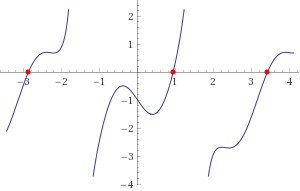How do you solve tan x - sin 3x = 1?
I know the answer is x = 0.93 radians, but I can't figure out this out using math.
Thanks for your help.
I know the answer is x = 0.93 radians, but I can't figure out this out using math.
Thanks for your help.
1 Answer
Explanation:
.
The most practical way to solve this equation is by using a graphing utility, visually determining the approximate roots, and then employing an iterative process to get as close as possible to the exact roots. Let's take a look at the graph of one period of the function:

As you can see, we have three roots that are close to:
By trying values to the left and right of each, we can get to the actual values with great accuracy.
But if we wanted to actually solve for
Using the following identity:
Using the identities:
Multiplying both sides by
Rearranging terms, we get:
Solving for
In order to solve for
Using the identity:
We can solve for
Multiplying both sides by
Let's figure out what
After foiling and combining like terms, we end up with:
Let's plug this in:
After foiling and combining like terms, we get:
For simplicity, let's let
This is a polynomial of degree
The other method is the Newton-Raphson method which says:
Start out with
Continuing this process, you can find the roots. It is a lengthy process and would exceed what Socratic would allow me to input. But you can look it up in calculus books and follow it.
Back to our equation, it turns out it has
The real roots are where it crosses the
Within one period of the function, we get three real values for
which are very close to what we observed at the beginning from the graph. You can try each of these values in the original problem equation and see that they work.

